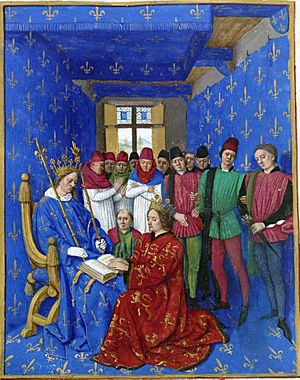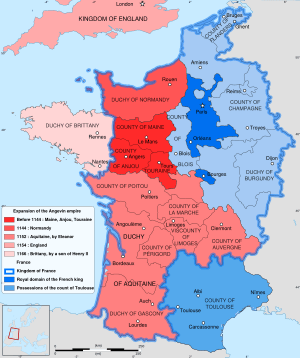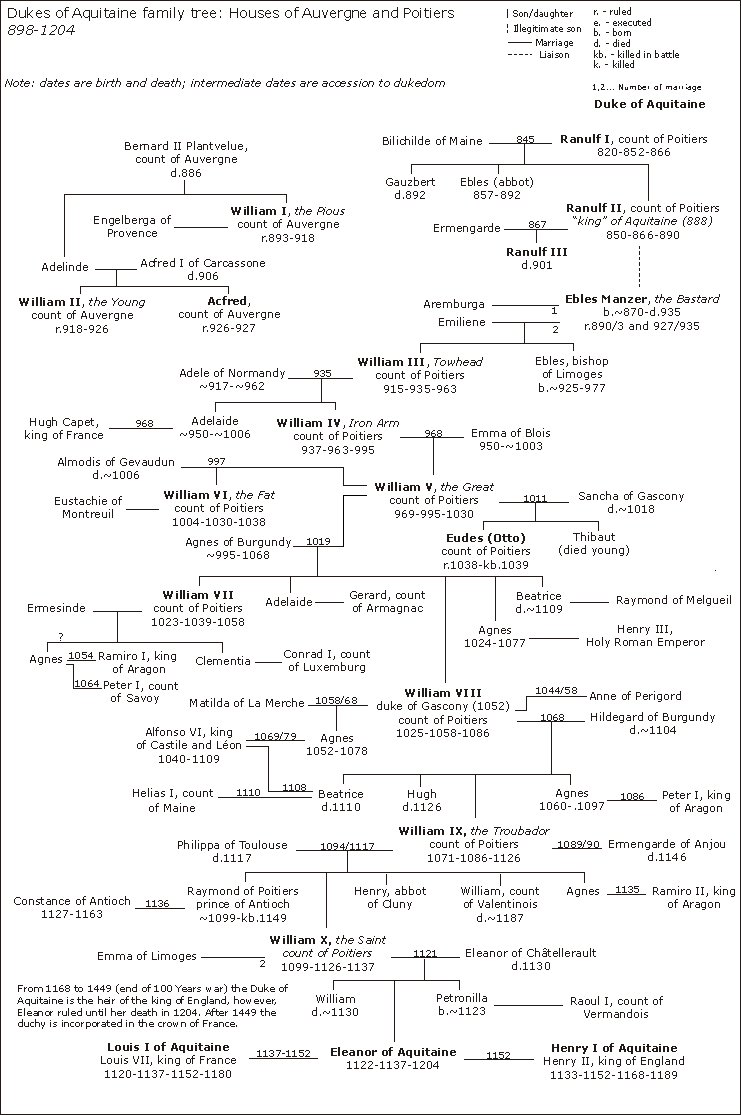Duke of Aquitaine facts for kids
The Duke of Aquitaine was a powerful ruler in the medieval region of Aquitaine. This area is in what is now France. The dukes ruled under the authority of different kings over time: first Frankish kings, then English kings, and finally French kings.
Aquitaine was once part of the Visigothic Kingdom. Because of this, it followed special laws called Visigothic law and Roman Law. These laws gave women more rights than in many other places at the time. For example, women could inherit land and titles. They could also manage their own property. They could even speak for themselves in court from age 14. They could also arrange their own marriages after age 20. This was very unusual for the time.
Contents
Becoming Duke: The Coronation Ceremony
The early kings and dukes of Aquitaine often used Toulouse as their main city. Later, other cities like Limoges and Poitiers became important.
The ceremony for crowning a Duke of Aquitaine was very special. It involved receiving several important items. The duke would get a silk cloak, a crown, a special banner, a sword, spurs, and a ring. This ring was linked to Saint Valerie. Limoges was seen as the capital of Aquitaine during these ceremonies.
Early Dukes Under Frankish Kings
Many different rulers held the title of Duke of Aquitaine. Some were powerful kings themselves. Others were appointed by the Frankish kings.
Merovingian and Carolingian Dukes
The first dukes were from the Merovingian family. Later, the Carolingian kings took direct control. They then started appointing dukes again. This duchy was also sometimes called Guyenne.
Here are some of the early dukes:
- Chram (555–560)
- Odo the Great (688–735) – He was a very important early duke.
- Hunald I (735–745) – Son of Odo the Great.
- Waifer (745–768) – Son of Hunald I.
Dukes from the House of Poitiers
The House of Poitiers, also known as the Ramnulfids, became very important. They ruled Aquitaine for many years.
- Ranulph I (852–866)
- Ranulph II (887–890) – He even called himself King of Aquitaine for a short time.
Dukes from the House of Auvergne
A few dukes came from the House of Auvergne:
- William I the Pious (893–918)
- William II the Younger (918–926)
Poitiers Dukes Return
The House of Poitiers came back to power:
- Ebalus the Bastard (927–932)
Later Dukes Before the Plantagenets
Other families also held the title for a short time, like the House of Rouergue and the House of Capet. But the House of Poitiers soon returned and ruled for a long period.
- William III Towhead (962–963)
- William V the Great (995–1030)
- William IX the Troubadour (1086–1127) – He was famous for his poetry and songs.
- William X the Saint (1127–1137)
Eleanor of Aquitaine and the Plantagenets
The most famous ruler of Aquitaine was Eleanor of Aquitaine (1137–1204). She was the daughter of William X. Eleanor was incredibly powerful. She married two kings: first the King of France, Louis the Younger, and then the King of England, Henry II.
When Eleanor married Henry II of England in 1152, the Duchy of Aquitaine became part of the lands ruled by the Plantagenet family. The Plantagenets were the kings of England. This meant the English kings now controlled a huge part of France. This often caused big problems and wars with the French kings. The English kings were very powerful, sometimes even more powerful than the French kings. They did not like having to show respect to the French king for their lands in France.
Plantagenet Rulers of Aquitaine
- Henry I (1152–1189) – King of England, duke through his wife Eleanor.
- Richard I Lionheart (1189–1199) – King of England, son of Henry II and Eleanor. He was a famous warrior king.
- John I (1199–1216) – King of England, son of Henry II and Eleanor.
- Henry II (1216–1272) – King of England.
- Edward I Longshanks (1272–1307) – King of England.

- Edward II (1307–1325) – King of England.
- Edward III (1325–1362) – King of England.
The Hundred Years' War and Aquitaine
In 1337, the King of France, Philip VI of France, tried to take Aquitaine back from Edward III. Edward III then claimed he should be the King of France! This started the Hundred Years' War, a very long conflict between England and France. Both sides wanted control over Aquitaine.
In 1360, a peace treaty was signed. Edward gave up his claim to the French crown. But he remained the ruler of Aquitaine, not just a duke. However, the peace did not last, and the war started again in 1369.
King Edward III made his eldest son, Edward the Black Prince, the Prince of Aquitaine.
- Edward the Black Prince (1362–1372) – Son of Edward III. He was a famous knight and military leader.
Later, other English royals were given the title:
- John of Gaunt (1390–1399) – Son of Edward III.
- Henry V of England (1400–1422) – King of England. He won important battles in France.
Henry V tried to make his family the rulers of France. But after he died, England slowly lost control of its lands in France.
French Kings and the Duchy
After the Hundred Years' War ended, Aquitaine came back under the direct rule of the King of France. The title of Duke of Aquitaine was sometimes given to a son of the French king, usually the Dauphin (the heir to the throne).
- John II (1345–1350) – Became King of France.
- Louis (1401–1415) – Son of Charles VI of France.
- Charles, Duc de Berry (1469–1472) – Son of Charles VII of France.
- Xavier (1753–1754) – A son of a French Dauphin.
Today, the title of Duke of Aquitaine is not officially used.
Family tree
See also
- List of Aquitainian consorts



